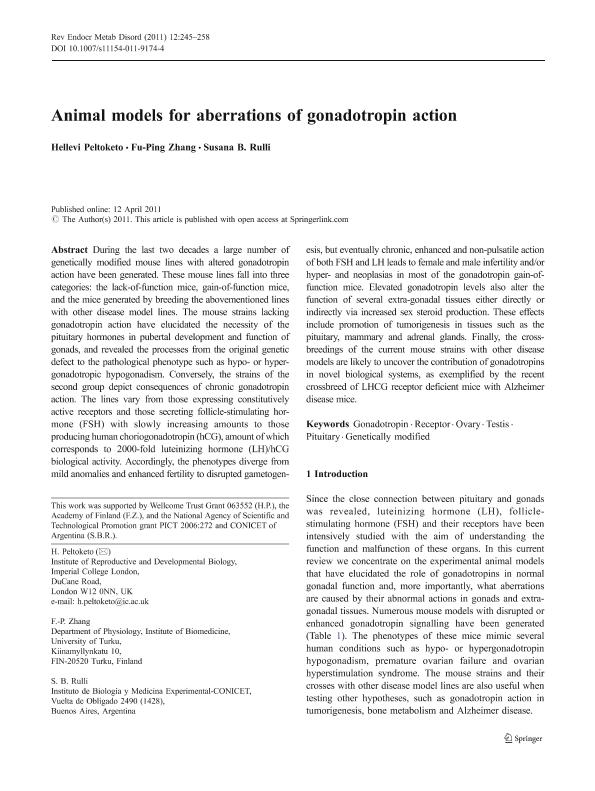Mostrar el registro sencillo del ítem
dc.contributor.author
Peltoketo, Hellevi
dc.contributor.author
Zhang, Fu Ping
dc.contributor.author
Rulli, Susana Beatriz

dc.date.available
2017-02-02T21:21:31Z
dc.date.issued
2011-12
dc.identifier.citation
Peltoketo, Hellevi ; Zhang, Fu Ping ; Rulli, Susana Beatriz; Animal models for aberrations of gonadotropin action; Springer; Reviews In Endocrine & Metabolic Disorders; 12; 4; 12-2011; 245-258
dc.identifier.issn
1389-9155
dc.identifier.uri
http://hdl.handle.net/11336/12416
dc.description.abstract
During the last two decades a large number of genetically modified mouse lines with altered gonadotropin action have been generated. These mouse lines fall into three categories: the lack-of-function mice, gain-of-function mice, and the mice generated by breeding the abovementioned lines with other disease model lines. The mouse strains lacking gonadotropin action have elucidated the necessity of the pituitary hormones in pubertal development and function of gonads, and revealed the processes from the original genetic defect to the pathological phenotype such as hypo- or hypergonadotropic hypogonadism. Conversely, the strains of the second group depict consequences of chronic gonadotropin action. The lines vary from those expressing constitutively active receptors and those secreting follicle-stimulating hormone (FSH) with slowly increasing amounts to those producing human choriogonadotropin (hCG), amount of which corresponds to 2000-fold luteinizing hormone (LH)/hCG biological activity. Accordingly, the phenotypes diverge from mild anomalies and enhanced fertility to disrupted gametogenesis, but eventually chronic, enhanced and non-pulsatile action of both FSH and LH leads to female and male infertility and/or hyper- and neoplasias in most of the gonadotropin gain-offunction mice. Elevated gonadotropin levels also alter the function of several extra-gonadal tissues either directly or indirectly via increased sex steroid production. These effects include promotion of tumorigenesis in tissues such as the pituitary, mammary and adrenal glands. Finally, the crossbreedings of the current mouse strains with other disease models are likely to uncover the contribution of gonadotropins in novel biological systems, as exemplified by the recent crossbreed of LHCG receptor deficient mice with Alzheimer disease mice.
dc.format
application/pdf
dc.language.iso
eng
dc.publisher
Springer

dc.rights
info:eu-repo/semantics/openAccess
dc.rights.uri
https://creativecommons.org/licenses/by-nc-sa/2.5/ar/
dc.subject
Gonadotropin
dc.subject
Receptor
dc.subject
Ovary
dc.subject
Testis
dc.subject
Pituitary
dc.subject
Genetically Modified
dc.subject.classification
Fisiología

dc.subject.classification
Medicina Básica

dc.subject.classification
CIENCIAS MÉDICAS Y DE LA SALUD

dc.title
Animal models for aberrations of gonadotropin action
dc.type
info:eu-repo/semantics/article
dc.type
info:ar-repo/semantics/artículo
dc.type
info:eu-repo/semantics/publishedVersion
dc.date.updated
2017-01-11T20:31:05Z
dc.identifier.eissn
1573-2606
dc.journal.volume
12
dc.journal.number
4
dc.journal.pagination
245-258
dc.journal.pais
Alemania

dc.journal.ciudad
Berlín
dc.description.fil
Fil: Peltoketo, Hellevi . Imperial College London; Reino Unido
dc.description.fil
Fil: Zhang, Fu Ping . University of Turku; Finlandia
dc.description.fil
Fil: Rulli, Susana Beatriz. Consejo Nacional de Investigaciones Científicas y Técnicas. Instituto de Biología y Medicina Experimental (i); Argentina
dc.journal.title
Reviews In Endocrine & Metabolic Disorders

dc.relation.alternativeid
info:eu-repo/semantics/altIdentifier/url/http://link.springer.com/article/10.1007%2Fs11154-011-9174-4
dc.relation.alternativeid
info:eu-repo/semantics/altIdentifier/doi/http://dx.doi.org/10.1007/s11154-011-9174-4
Archivos asociados
